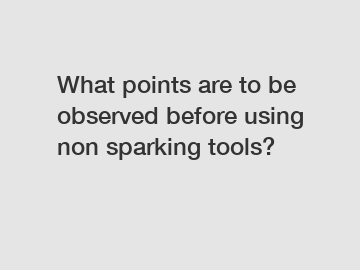What points are to be observed before using non sparking tools?
Sikai are exported all over the world and different industries with quality first. Our belief is to provide our customers with more and better high value-added products. Let's create a better future together.
When it comes to working in industries where flammable gases, liquids, or substances are present, safety becomes paramount. In these hazardous environments, the need for non-sparking tools cannot be understated. Designed to minimize the risk of ignition and potential disasters, non-sparking tools are a vital asset for workers operating in potentially explosive atmospheres. However, before using these tools, it is crucial to understand and observe some key points to ensure maximum safety and effectiveness.
1. Familiarize Yourself with Non-Sparking Tools:

Non-sparking tools are specifically engineered to eliminate sparks by using materials that do not create friction. They are typically made of alloys such as copper beryllium (CuBe) or aluminum bronze (AlBr). Before using non-sparking tools, familiarize yourself with their distinctive design, appearance, and unique properties. Understand their limitations and how they differ from regular tools to ensure proper usage and safety.
2. Assess the Hazardous Environment:
Before working in an environment that necessitates non-sparking tools, undertake a thorough risk assessment. Identify potential sources of flammable substances, gases, or dust. Determine the explosion hazard class and zoning to establish the appropriate level of safety precautions required. If unsure, consult relevant safety experts or regulations to accurately gauge the risks involved.
3. Choose the Right Non-Sparking Tools:
Selecting the appropriate non-sparking tools is crucial to ensure both safety and effectiveness. Consider the specific tasks you will perform and choose the tools that suit those requirements. Assess the potential hazards at hand and, if needed, seek expert advice to determine the optimal tools for your application. Remember, using the wrong tool may compromise safety, so make an informed decision.
4. Regular Maintenance and Inspection:
Non-sparking tools require periodic maintenance and inspection to guarantee their efficiency and safety. Regularly check for any signs of wear, damage, or deterioration. Inspect handles, cutting edges, and other critical parts for any abnormalities or defects. Create a maintenance schedule and adhere to it diligently to ensure your tools are always in top condition.
5. Proper Storage and Handling:
When it comes to non-sparking tools, proper storage and handling are essential. After use, clean the tools thoroughly and remove any debris or residue. Store them in designated areas away from sources of ignition and potentially hazardous substances. Remember, even the most reliable tools can pose risks if mishandled or stored incorrectly.
6. Continuous Training and Awareness:
To maximize safety, ensure workers undergo comprehensive training on the proper use of non-sparking tools. Create awareness programs to reinforce the importance of using these tools in hazardous environments. Encourage an open communication culture to address any concerns or suggestions regarding safety and tool usage. By fostering a continuous learning environment, potential risks can be minimized.
7. Regular Safety Drill Exercises:
Conducting regular safety drill exercises is paramount to familiarize workers with emergency protocols in case of an incident. These drills should include scenarios specific to the hazardous environments where non-sparking tools are used. Practice the correct response to emergencies, including using non-sparking tools as part of the overall safety plan.
Conclusion:
When working in potentially explosive environments, prioritizing safety is of utmost importance. Non-sparking tools play a pivotal role in minimizing sparks and reducing the risk of ignition. By following these key points - familiarizing yourself with the tools, assessing the environment, proper tool selection, maintenance, handling, training, and ongoing safety drills - you can significantly enhance safety and protect both yourself and others. Remember, ensuring safety should always be the top priority before using non-sparking tools.
For more information, please visit Non-Sparking Adjustable Combination Pliers.
117
0
0


Comments
All Comments (0)